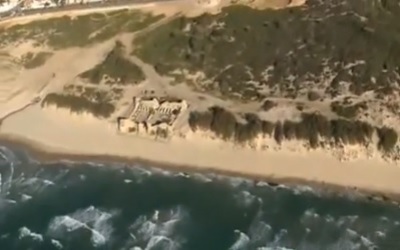Israel Bible Assyrian Wall Unearthed by Archaeologists Near Tel Aviv (PHOTO)

Israeli archaeologists have found massive ancient ruins that appear to represent the fortress defending the city of Ashdod in the 8th Century B.C. from an Assyrian takeover, as found in the Bible's book of Isaiah.
The walls, which were uncovered by Tel Aviv University archaeologists at a site known as Ashdod-Yam, just south of Tel Aviv, consist of crescent-shaped fortifications which would have protected the inland from the sea for a 17 acre span. The walls appear to have created an artificial harbor for the ancient land, known today as modern-day Israel.
"The fortifications appear to protect an artificial harbor," Tel Aviv University's Alexander Fantalkin, leader of the dig at Ashdod-Yam, said in a press release earlier this week. "If so, this would be a discovery of international significance, the first known harbor of this kind in our corner of the Levant."
"An amazing amount of time and energy was invested in building the wall and glacis [embankments]," Fantalkin added.
Dr. Fantalkin added to the Israeli newspaper Arutz Sheva that the fortifications found are "extremely well preserved and impressive," and it is "quite rare to discover such a well preserved site."
The walls, constructed out of mud bricks, are suspected to have been built during the Iron Age, and the largest portion of the protective walls stand 12 feet long and 15 feet high. The core consists of mud, while following layers alternate between sand and mud extending outward several feet.
Those archaeologists participating in this summer's Tel Aviv University Institute of Archaeology excavation site at Ashdod-Yam have also unearthed coins and weights dating back to the Hellenistic period.
In the Bible's book of Isaiah, Sargon II, an Assyrian king, successfully captures the city of Ashdod in 711 BC. A rebel Philistine king of Ashdod, named Yamani, then attempted to lead a revolt against the leader Sargon II, but ultimately failed. The fortifications reportedly date back to the time of this attempted rebellion, although archaeologists argue they were not built in haste in response to the threat of a revolution. Following the failed revolt organized by Yamani, the ancient city was destroyed.
Here is a related video:





























